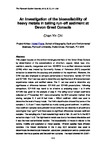An investigation of the bioavailability of heavy metals in tailing run-off sediment at Devon Great Consols
| dc.contributor.author | Yin Chi, C. | |
| dc.date.accessioned | 2019-05-16T09:59:30Z | |
| dc.date.available | 2019-05-16T09:59:30Z | |
| dc.date.issued | 2013 | |
| dc.identifier.citation |
Yin Chi, C. (2013) 'An investigation of the bioavailability of heavy metals in tailing run-off sediment at Devon Great Consols', The Plymouth Student Scientist, 6(2), p. 211-309. | en_US |
| dc.identifier.issn | 1754-2383 | |
| dc.identifier.uri | http://hdl.handle.net/10026.1/14041 | |
| dc.description.abstract |
This project focuses on the environmental geochemistry of the Devon Great Consols by determination of the concentrations of chromium, copper, nickel, lead, zinc, cadmium, arsenic, manganese and iron. BCR®701 is a certified reference material (CRM) which was treated by Community Bureau of Reference (BCR) sequential extraction to determine the accuracy and precision of the experiment. Moreover, the CRM was also employed to compare performance of instruments, namely ICP-AES and ICP-MS. The T-test was used to determine any significance of difference between experimental values and certified values. The F- test was used to determine any significance of difference between ICP-AES and ICP-MS presentations. Following comparison, ICP-AES was found to be effective at analysing steps 1 to 3 while ICP-MS was good for the analysis of step 2. The tailing run-off stream sediments collected on 1st November 2011 were extracted by the BCR extraction method. After sieving, samples 2, 4 and 8 had more < 250μm sediment which was used to determine the level of heavy metals. The Folk’s classification showed that some of the samples 1, 3, 6 and 7 were classified as muddy sandy gravel sediment. In addition, most sediment samples were yellowish brown while the wet densities in all sediments were higher than 1gcm-3 and there were no significant differences between sediment samples. The sampling site 2 had revealed high level of Mn, Zn and Fe in the BCR extraction steps 1 to 3. The high level of metals was due to the mineral dissolution and it was the most contaminated location. The bioavailability of metals is related to the toxicity, mobility and speciation of metal species. Different species have different toxicities. The metals’ distribution in the 3 step BCR extraction was used to determinate the electrostatic interaction, adsorption, precipitation and co- precipitation between the metal species and the sediment surfaces. The result showed Mn (0.821- 0.123%) has the most mobility in the environment. The most bioavailable metal was Fe (7837 - 15313 mgkg-1) followed by As (68.1 - 3867 mgkg-1) and Cu (344.3 - 684.0 mgkg-1). These metals were hazardous to the environment (e.g. accumulation in organisms and plants). The bioavailable metals had an effect on Gunnislake, which is a town located downstream of the Tamar River. | en_US |
| dc.language.iso | en | en_US |
| dc.publisher | University of Plymouth | |
| dc.rights | Attribution 3.0 United States | * |
| dc.rights.uri | http://creativecommons.org/licenses/by/3.0/us/ | * |
| dc.subject | environmental geochemistry | en_US |
| dc.subject | Devon Great Consols | en_US |
| dc.subject | chromium | en_US |
| dc.subject | copper | en_US |
| dc.subject | nickel | en_US |
| dc.subject | lead | en_US |
| dc.subject | zinc | en_US |
| dc.subject | cadmium | en_US |
| dc.subject | arsenic | en_US |
| dc.subject | manganese | en_US |
| dc.subject | iron | en_US |
| dc.subject | ICP-MS | en_US |
| dc.subject | ICP-AES | en_US |
| dc.subject | bioavailable metals | en_US |
| dc.title | An investigation of the bioavailability of heavy metals in tailing run-off sediment at Devon Great Consols | en_US |
| dc.type | Article | |
| plymouth.issue | 2 | |
| plymouth.volume | 6 | |
| plymouth.journal | The Plymouth Student Scientist |



